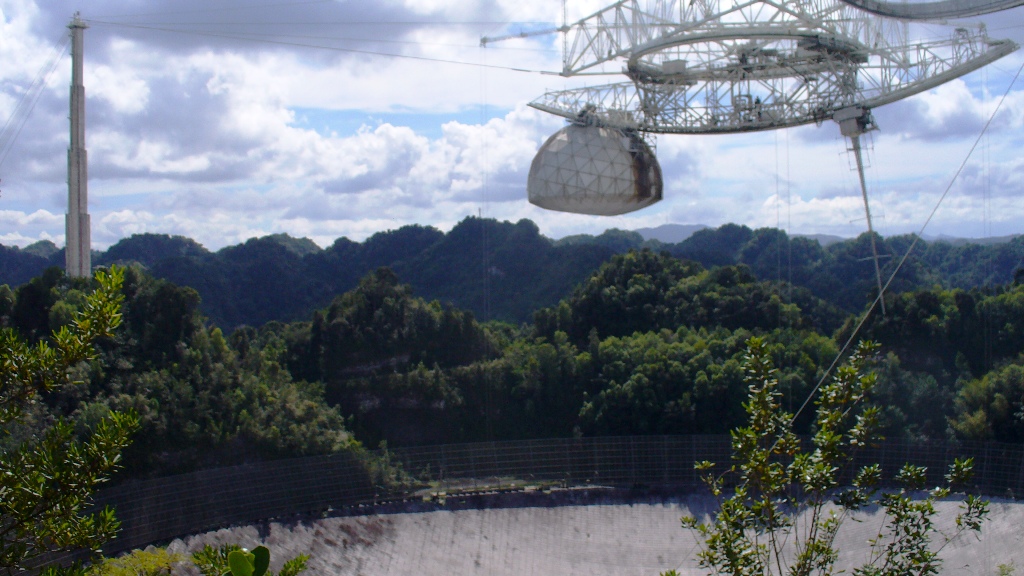The telescope has three
radar transmitters, with
effective isotropic radiated powers
of 20 TW at 2380 MHz, 2.5 TW (pulse peak) at
430 MHz, and 300 MW at 47 MHz.
The
telescope is a
spherical reflector, not a
parabolic reflector. To aim the
telescope, the receiver is moved to
intercept signals reflected from different
directions by the spherical dish surface. A
parabolic mirror would induce a varying
astigmatism when the receiver is
in different positions off the focal point,
but the
error of a spherical mirror is
the same in every direction.
The receiver is located on a 900-ton
platform which is suspended 150 m (500 ft)
in the air above the dish by 18 cables
running from three
reinforced concrete towers, one of which
is 110 m (365 ft) high and the other two of
which are 80 m (265 ft) high (the tops of
the three towers are at the same elevation).
The platform has a 93-meter-long rotating
bow-shaped track called the
azimuth arm on which receiving
antennas, secondary and tertiary reflectors
are mounted. This allows the telescope to
observe any region of the sky within a
forty-degree cone of visibility about the
local
zenith (between -1 and 38 degrees
of
declination).
Puerto Rico's location near the
equator allows Arecibo to view
all of the planets in the Solar System,
though the round trip light time to objects
beyond
Saturn is longer than the time
the telescope can track it, preventing
radar observations of more distant
objects.
Many significant scientific
discoveries have been made using the Arecibo
telescope. On 7 April 1964, shortly after it
began operations,
Gordon Pettengill's team used it
to determine that the
rotation rate of
Mercury was not 88 days, as
previously thought, but only 59 days.
In 1968, the discovery of the periodicity of
the
Crab Pulsar (33 milliseconds) by
Lovelace and others provided the first solid
evidence that
neutron stars exist.
In 1974,
Hulse and
Taylor discovered the first
binary pulsar
PSR B1913+16,
an accomplishment for which they later
received the
Nobel Prize in Physics. In 1982,
the first
millisecond pulsar,
PSR B1937+21, was discovered by
Donald C. Backer,
Shrinivas Kulkarni,
Carl Heiles, Michael Davis, and
Miller Goss.
This object spins 642 times per second, and
until the discovery of
PSR J1748-2446ad in 2005, it was
the fastest-spinning pulsar known. In August 1989, the
observatory directly imaged an
asteroid for the first time in history:
4769 Castalia.
The following year, Polish astronomer
Aleksander Wolszczan made the
discovery of
pulsar
PSR B1257+12, which later led him
to discover its three orbiting planets and a
possible comet.
These were the first
extra-solar planets discovered.
In 1994, John Harmon used the Arecibo radio
telescope to map the distribution of ice in
the poles of
Mercury.
In January 2008, detection of
prebiotic molecules
methanimine and
hydrogen cyanide were reported
from Arecibo Observatory radio spectroscopy
measurements of the distant starburst galaxy
Arp 2200.



